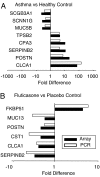Genome-wide profiling identifies epithelial cell genes associated with asthma and with treatment response to corticosteroids
- PMID: 17898169
- PMCID: PMC2000427
- DOI: 10.1073/pnas.0707413104
Genome-wide profiling identifies epithelial cell genes associated with asthma and with treatment response to corticosteroids
Abstract
Airway inflammation and epithelial remodeling are two key features of asthma. IL-13 and other cytokines produced during T helper type 2 cell-driven allergic inflammation contribute to airway epithelial goblet cell metaplasia and may alter epithelial-mesenchymal signaling, leading to increased subepithelial fibrosis or hyperplasia of smooth muscle. The beneficial effects of corticosteroids in asthma could relate to their ability to directly or indirectly decrease epithelial cell activation by inflammatory cells and cytokines. To identify markers of epithelial cell dysfunction and the effects of corticosteroids on epithelial cells in asthma, we studied airway epithelial cells collected from asthmatic subjects enrolled in a randomized controlled trial of inhaled corticosteroids, from healthy subjects and from smokers (disease control). By using gene expression microarrays, we found that chloride channel, calcium-activated, family member 1 (CLCA1), periostin, and serine peptidase inhibitor, clade B (ovalbumin), member 2 (serpinB2) were up-regulated in asthma but not in smokers. Corticosteroid treatment down-regulated expression of these three genes and markedly up-regulated expression of FK506-binding protein 51 (FKBP51). Whereas high baseline expression of CLCA1, periostin, and serpinB2 was associated with a good clinical response to corticosteroids, high expression of FKBP51 was associated with a poor response. By using airway epithelial cells in culture, we found that IL-13 increased expression of CLCA1, periostin, and serpinB2, an effect that was suppressed by corticosteroids. Corticosteroids also induced expression of FKBP51. Taken together, our findings show that airway epithelial cells in asthma have a distinct activation profile and identify direct and cell-autonomous effects of corticosteroid treatment on airway epithelial cells that relate to treatment responses and can now be the focus of specific mechanistic studies.
Conflict of interest statement
The authors declare no conflict of interest.
Figures



References
-
- Boushey HA, Corry DB, Fahy JV, Burchard EG, Woodruff PG. In: Murray and Nadel's Textbook of Respiratory Medicine. Mason RJ, Broaddus CV, Murray JF, Nadel JA, editors. Vol 1. Philadelphia: Elsevier Saunders; 2005. pp. 1168–1216.
-
- Cookson W. Nat Rev Immunol. 2004;4:978–988. - PubMed
-
- Cockcroft DW, Davis BE. J Allergy Clin Immunol. 2006;118:551–559. - PubMed
-
- Holgate ST, Holloway J, Wilson S, Bucchieri F, Puddicombe S, Davies DE. Proc Am Thorac Soc. 2004;1:93–98. - PubMed
-
- Kuperman DA, Huang X, Koth LL, Chang GH, Dolganov GM, Zhu Z, Elias JA, Sheppard D, Erle DJ. Nat Med. 2002;8:885–889. - PubMed
Publication types
MeSH terms
Substances
Associated data
- Actions
Grants and funding
- R01 HL085089/HL/NHLBI NIH HHS/United States
- HL080414/HL/NHLBI NIH HHS/United States
- RR00083/RR/NCRR NIH HHS/United States
- CA020535/CA/NCI NIH HHS/United States
- HL66564/HL/NHLBI NIH HHS/United States
- RR00079/RR/NCRR NIH HHS/United States
- RR17002/RR/NCRR NIH HHS/United States
- P50 HL056385/HL/NHLBI NIH HHS/United States
- R01 CA020535/CA/NCI NIH HHS/United States
- M01 RR000079/RR/NCRR NIH HHS/United States
- HL72301/HL/NHLBI NIH HHS/United States
- R01 HL066564/HL/NHLBI NIH HHS/United States
- R01 HL072301/HL/NHLBI NIH HHS/United States
- K23 RR017002/RR/NCRR NIH HHS/United States
- R01 HL080414/HL/NHLBI NIH HHS/United States
- R37 CA020535/CA/NCI NIH HHS/United States
- HL5683/HL/NHLBI NIH HHS/United States
- M01 RR000083/RR/NCRR NIH HHS/United States
LinkOut - more resources
Full Text Sources
Other Literature Sources
Medical
Molecular Biology Databases
Miscellaneous

